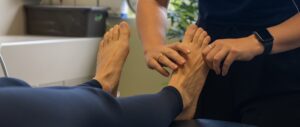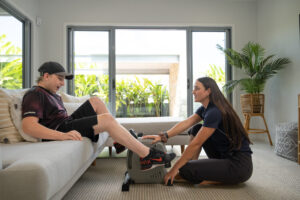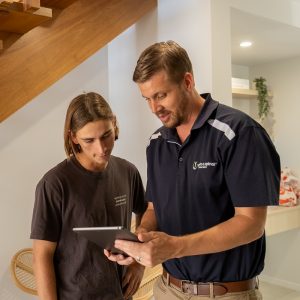Foot Care Without Limits: How Mobile Podiatry is Transforming Patient Outcomes

For many Australians, mobility issues prevent them from receiving regular foot care, leading to worsening health conditions. Mobile podiatry is changing that by bringing expert foot care directly to patients’ homes, allowing those with limited mobility to receive consistent, high-quality care.
Mobile podiatry offers a flexible, patient-centred approach to foot care, making treatment accessible for individuals who struggle to attend traditional clinic appointments. This innovative model not only enhances convenience but also leads to better long-term health outcomes for those managing chronic conditions or mobility challenges.
What is Mobile Podiatry?
Mobile podiatry involves podiatrists travelling to a patient’s home to provide comprehensive foot care services. These services range from routine nail care and callus removal to more complex treatments like managing diabetic foot ulcers, orthotics consultations, and assessments for arthritis-related foot pain. By offering these services outside of traditional clinical settings, mobile podiatrists ensure that essential foot care is accessible to those who need it most.
Mobile podiatry is especially beneficial for patients who experience difficulty travelling to appointments due to mobility restrictions. This includes elderly patients, people with disabilities, and individuals managing chronic conditions such as diabetes, who often require consistent and specialised foot care. Mobile podiatry is also ideal for busy individuals who may find it difficult to fit clinic appointments into their schedules.
The Benefits of Mobile Podiatry for Patients

- Convenience and Comfort
Receiving foot care at home eliminates the challenges of transportation, long waiting times, or navigating public spaces for individuals with mobility issues. Patients can access expert podiatric care in the comfort and privacy of their own homes, ensuring they receive the treatment they need without added stress. For elderly or disabled individuals, this service can make a significant difference in their quality of life. - Continuity of Care
For patients managing chronic conditions like diabetes or arthritis, consistent care is vital. Regular at-home visits from a mobile podiatrist help monitor ongoing health issues, preventing small problems from escalating into severe complications. This continuity of care ensures that treatment is adjusted as needed, promoting better long-term health outcomes and reducing the likelihood of hospital admissions. - Personalised Treatment Plans
Seeing patients in their home environment allows podiatrists to better understand the patient’s lifestyle, daily routines, and specific challenges. This leads to more tailored treatment plans that address the individual’s unique needs. Whether it’s identifying hazards in the home that contribute to foot problems or recommending the right footwear for daily use, mobile podiatry offers a level of personalization that traditional clinics often cannot.
How to Maximise the Benefits of Mobile Podiatry at Home
Mobile podiatry services are designed to bring high-quality foot care right to your doorstep, offering unmatched convenience and personalised care. However, to truly maximise the benefits of mobile podiatry, patients can take a few additional steps to ensure they get the most out of every visit. Here are some practical ways to enhance the effectiveness of mobile podiatry treatments at home:
- Prepare Your Space for the Visit
Just as you would prepare for a clinic appointment, creating an environment at home that allows the podiatrist to work efficiently is essential. Here’s how:- Create a Clean, Comfortable Space
Ensure that the area where your podiatrist will work is clean, well-lit, and free from distractions. A comfortable chair with good access to your feet can make the session run more smoothly. - Have Essential Items Ready
If your podiatrist has recommended specific tools like orthotics, shoes, or foot care products, have them ready before the appointment. This will allow the podiatrist to easily assess their effectiveness or make adjustments as needed.
- Create a Clean, Comfortable Space
- Ask Questions and Stay Informed
Your mobile podiatrist is a valuable resource for understanding your foot health. To get the most out of each visit:
-
- Ask About Prevention
Don’t hesitate to ask your podiatrist about preventive foot care. Whether it’s tips on selecting proper footwear, exercises to strengthen your feet, or advice on managing chronic conditions like diabetes, this information can help you avoid future issues. - Track Your Symptoms
Keep a log of any changes in your foot health between appointments. For example, if you notice increased pain, swelling, or difficulty walking, share these details with your podiatrist so they can make the necessary adjustments to your care plan. - Request Educational Resources
Ask your podiatrist for recommendations on trusted foot care resources, whether online guides, exercises, or instructional videos. Staying informed empowers you to take an active role in maintaining your foot health between visits.
- Ask About Prevention
- Stick to the Recommended Care Routine
A major advantage of mobile podiatry is the personalised care plan you receive, which often includes at-home care routines. To ensure the best results:
-
- Follow Home Care Instructions
Your podiatrist may suggest daily exercises, stretches, or skincare routines to maintain your foot health. Make it a habit to follow these instructions regularly, as they are designed to reinforce the treatment you receive during your sessions. - Stay Consistent with Footwear Recommendations
If your podiatrist recommends specific types of shoes or orthotic inserts, wearing them consistently can significantly improve your foot health. Consistency in following these guidelines can help prevent future issues such as plantar fasciitis, bunions, or corns. - Monitor and Report Progress
Share your progress with your podiatrist during each visit. If certain aspects of your care plan are not working or you notice significant improvements, letting your podiatrist know will help them fine-tune your treatment plan.
- Follow Home Care Instructions
- Use Technology for Continuous Care
 Mobile podiatry services are increasingly integrating telehealth and digital tools to keep track of patients’ progress between visits. Take advantage of these technologies:
Mobile podiatry services are increasingly integrating telehealth and digital tools to keep track of patients’ progress between visits. Take advantage of these technologies:
-
- Schedule Telehealth Check-ins
If your podiatrist offers telehealth services, use them for quick consultations or follow-up appointments that don’t require in-person visits. This ensures ongoing communication and allows for timely interventions when necessary. - Use Foot Health Apps
Some podiatrists may recommend mobile apps that help track foot health metrics such as pain levels, walking patterns, or foot pressure. These apps can provide valuable data that your podiatrist can use to adjust your care plan.
- Schedule Telehealth Check-ins
- Prioritise Regular Appointments
Consistency is key to maintaining foot health, especially for individuals with chronic conditions like diabetes or arthritis. Make sure to:
-
- Book Appointments in Advance
Don’t wait until you’re in pain or facing a complication to schedule a podiatry appointment. Proactive, regular check-ups help identify potential issues early, preventing them from developing into more serious problems. - Follow the Recommended Visit Frequency
If your podiatrist recommends visits every few weeks or months, stick to that schedule. Consistent monitoring and care ensure your foot health stays on track and reduces the risk of setbacks.
- Book Appointments in Advance
- Communicate Any Changes in Your Health
Your foot health is connected to your overall health, so it’s important to keep your podiatrist informed of any new conditions or changes in your wellbeing.- Report New Symptoms
Whether it’s a change in your mobility, circulation, or sensation in your feet, promptly report these changes to your podiatrist. This can help them address potential issues before they escalate, such as peripheral neuropathy in diabetic patients or circulatory problems in elderly individuals. - Share Updates on Other Medical Conditions
If you’re being treated for other medical conditions, such as heart disease or arthritis, these may affect your feet. Keeping your podiatrist informed ensures they can tailor your foot care to complement your overall treatment plan.
- Report New Symptoms
The Wrap Up
Mobile podiatry is a transformative solution for individuals with mobility limitations, chronic conditions, or busy schedules who need consistent foot care. By bringing expert care directly to patients’ homes, mobile podiatry removes the barriers to accessing essential treatments, improving patient outcomes and overall quality of life.
If you or a loved one could benefit from personalised, at-home foot care, contact us today to learn more about our mobile podiatry services. Let us bring expert foot care to you, ensuring your feet stay healthy and strong without the need for clinic visits.
For more information or to schedule a consultation, call us at 1300 685 046 or fill out our contact form.
